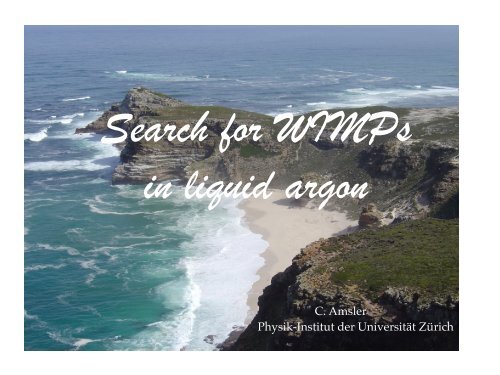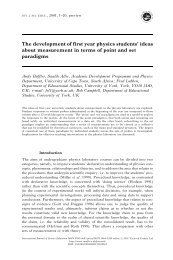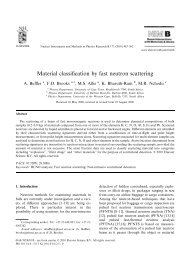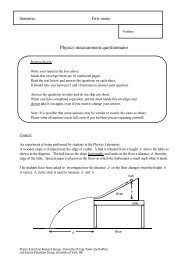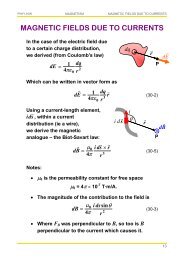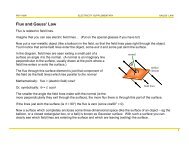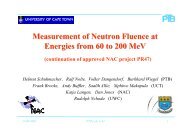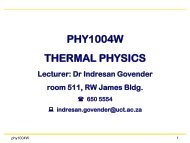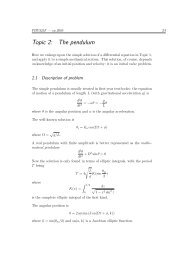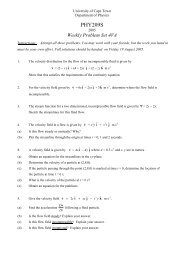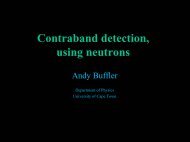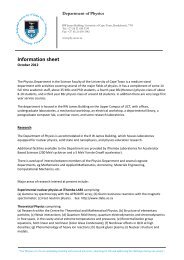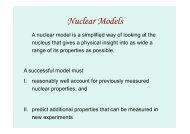C. Amsler Physik-Institut der Universität Zürich
C. Amsler Physik-Institut der Universität Zürich
C. Amsler Physik-Institut der Universität Zürich
Create successful ePaper yourself
Turn your PDF publications into a flip-book with our unique Google optimized e-Paper software.
Search for WIMPs<br />
in liquid argon<br />
C. <strong>Amsler</strong><br />
<strong>Physik</strong>-<strong>Institut</strong> <strong>der</strong> <strong>Universität</strong> <strong>Zürich</strong>
WIN’11, CapeTown, 31 January 2011, C. <strong>Amsler</strong><br />
Abstract: The DARWIN Collaboration has been funded by ASPERA to prepare a proposal for a<br />
next generation of WIMP searches using noble liquids. The University of Zurich is performing<br />
R&D to detect the VUV light from recoiling nuclei. I will present results obtained with 1 ton of<br />
liquid argon (ArDM project) and discuss the response to neutrons using a monochromatic neutron<br />
source.<br />
Progress report on some of the developments at CERN towards the<br />
construction a large liquid argon (LAr) detector for dark matter searches.<br />
Liquid argon technology for dark matter<br />
searches is still in its infancy<br />
1) Brief review on dark matter<br />
2) Future project, DARWIN consortium<br />
3) R&D on light readout in liquid argon<br />
4) First results from 1 ton LAr (ArDM)<br />
5) Response LAr to neutrons<br />
6) Conclusions<br />
C. <strong>Amsler</strong> et al. (ArDM Coll.) JINST 5 (2010) P11003<br />
(and ref. therein)<br />
V. Boccone, PhD thesis, Univ. Zurich, 2010<br />
2
• Fritz Zwicky (1933) from the movements of galaxies in<br />
clusters using the virial theorem: Ttotal much too large<br />
• Vera Rubin (1970) from the speed of stars in spiral galaxies<br />
Andromeda<br />
Astrophysical evidences for dark matter<br />
v<br />
1/r 1/2<br />
Milky Way<br />
5 x more dark matter<br />
than ordinary matter<br />
• Most impressive:<br />
Collision of galaxies in the Bullet Cluster (1E0657-558)<br />
X-ray emission from baryonic matter slowing<br />
down (electromagnetic repulsion)<br />
Center of mass from<br />
gravitational lensing<br />
WIN’11, CapeTown, 31 January 2011, C. <strong>Amsler</strong> 3<br />
r<br />
© 1994 Deneba Systems, Inc.
V(baryons)= 4 %<br />
V(dark matter) = 20%<br />
Nature of dark matter (DM)<br />
but only 1% of baryonic mass is visible!<br />
Energy pizza<br />
V(dark energy) = 76%<br />
Nature of DM = elementary particles are stable and weak interacting (survival)<br />
Interaction:<br />
• gravitational (+ weak)<br />
• no electromagnetic interaction<br />
Neither emission nor absorption of light<br />
Should be called instead transparent matter<br />
WIN’11, CapeTown, 31 January 2011, C. <strong>Amsler</strong> 4
Most popular:<br />
WIN’11, CapeTown, 31 January 2011, C. <strong>Amsler</strong><br />
II) Axions: a -> gg: Mean life ≫ age of universe for M < 10 eV<br />
M < 0.01 eV otherwise a -> gg enhances cooling in red giants<br />
M = 10-3 - 10-5 eV<br />
CAST expriment at CERN (axions from the sun) M < 0.02 eV<br />
g<br />
a<br />
g<br />
9T<br />
III) WIMPs: Weakly Interacting Massive Particles<br />
e.g. the neutralino x1 of predicted by supersymmetry<br />
excluded<br />
DM candidates, see e.g. RPP 2010, M. Drees and G. Gerbier<br />
I) Neutrinos (unlikely)<br />
Early universe: g e + e - nini until decoupling at T ≈ 1 MeV<br />
Critical density (V = 1 ) requires mne + mnm + mnt ≃ 50 eV but neutrinos are<br />
much lighter. Heavy neutrinos should decay<br />
< 45 GeV (LEP)<br />
M ≈ 100 GeV - a few TeV<br />
5
Ar, Xe<br />
WIN’11, CapeTown, 31 January 2011, C. <strong>Amsler</strong><br />
Invisible<br />
nuclear recoil 0 - 100 keV<br />
light, ionization, phonons<br />
Best limits:<br />
Spin independent ~ A 2 boost<br />
Current upper limits on sN<br />
3.4 x 10 -44 cm 2 @ 55 GeV<br />
(CDMS, XENON-100)<br />
Weak interaction: needs very large targets<br />
Laboratory (non-accelerator) searches<br />
χ χ<br />
Z 0 , H, h<br />
q q<br />
χ χ<br />
q ~<br />
q q<br />
E. Aprile et al., PRL 105 (2010) 131302<br />
SUSY<br />
6
Future laboratory searches: coordination needed!!<br />
I) Cryogenic detectors<br />
T < 100 mK (bolometers)<br />
Phonons and ionization, EDELWEISS, CDMS<br />
Phonons and scintillation, CRESST<br />
Future generation: 100 x more sensitive<br />
e.g. EURECA- consortium: EDELWEISS + CRESST<br />
10 kg to 1000 kg<br />
Advantages: high resolution, nearly background free<br />
Signal proportional to measurement time<br />
II) Noble liquids<br />
ZEPLIN, ArDM, WARP, DEAP, MINICLEAN,<br />
XENON-10,100...<br />
Future generation: DARWIN-consortium (Xe, Ar)<br />
LUX in the USA (Xe), CLEAN, DEAP-3000 (Ar)<br />
Advantage: large masses, Ar is cheap<br />
However: signal proportional to square root of<br />
measurement time<br />
WIN’11, CapeTown, 31 January 2011, C. <strong>Amsler</strong> 8
Goal:<br />
DARWIN = DARk matter WImp search with Noble liquids<br />
(L. Baudis, Spokesperson)<br />
(funded by ASPERA)<br />
Regroups current participants in<br />
ArDM /WARP / XENON<br />
8t LAr<br />
5t LXe<br />
Laura Baudis: arXiv:1012.4764v1 [astro-ph.IM] 21 Dec 2010<br />
(Identification of Dark Matter 2010-IDM2010 July 26-30, 2010 Montpellier France)<br />
Concept of a multiton detector for DM search in Europe using LXe and /<br />
or LAr: design report by 2013, operation by 2016.<br />
Target: sensitivity around 10 -47 cm 2 (3 or<strong>der</strong>s of magnitude improvement)<br />
WIN’11, CapeTown, 31 January 2011, C. <strong>Amsler</strong> 9
Rate/day in a 1 ton liquid Ar detector<br />
r (local) = 0.3 GeV/cm 3<br />
v = 245 km/s (June), 215 km (December)<br />
M(WIMP) = 100 GeV, s = 10 -42 cm 2<br />
•at 10 -45 cm 2 : 0.1 event /day @ 30<br />
keV threshold in LAr<br />
•LAr and LXe are complementary<br />
WIN’11, CapeTown, 31 January 2011, C. <strong>Amsler</strong><br />
Liquid argon<br />
1/v 2<br />
Rate d -1<br />
1000<br />
100<br />
10<br />
1<br />
s[cm 2 ]<br />
10 -45<br />
10 -47<br />
dσ<br />
dq2 = G2F CF2 (q2 )<br />
v2 30 keV<br />
100 evts/day<br />
Xenon<br />
Argon<br />
Xenon<br />
0 20 40 60 80 100<br />
Threshold [keV]<br />
Argon<br />
J/D<br />
20 100<br />
Nuclear recoil energy [keV]<br />
Years<br />
Form<br />
factor<br />
10
light<br />
128 nm<br />
WIN’11, CapeTown, 31 January 2011, C. <strong>Amsler</strong><br />
Density 1.4 g/cm 3<br />
Refractive index 1.24<br />
Scintillation yield<br />
(E=0)<br />
Boiling point 87 K<br />
Interaction<br />
length<br />
≈50‘000 g/MeV<br />
@128 nm<br />
83.6 cm<br />
Price 1€ / liter<br />
Radioactive<br />
isotopes<br />
39 Ar isotope (b)<br />
T1/2 = 269 yrs,<br />
Q = 565 keV,<br />
1 Bq/kg<br />
11
Ar2* argon excimers<br />
1S (t1 = 5ns),<br />
3S (t3 = 1.6 ms)<br />
in liquid argon<br />
WIN’11, CapeTown, 31 January 2011, C. <strong>Amsler</strong><br />
Scintillation mechanism in liquid argon<br />
pressure dependent<br />
128 nm, 10 nm band<br />
Tetra-Phenyl-Butadiene (TPB)<br />
128 nm -> 430 nm<br />
Wavelength shifter needed<br />
12
a- source<br />
Signal Amplitude [V]<br />
0<br />
-0.2<br />
-0.4<br />
-0.6<br />
-0.8<br />
Light readout R&D in gaseous and liquid argon<br />
1 GHz sampling rate<br />
0 5 10<br />
t [µs]<br />
15<br />
b b a<br />
1p.e.<br />
1 event<br />
20<br />
Events / 7.5 p.e.<br />
source<br />
50<br />
40<br />
30<br />
20<br />
10<br />
0<br />
74 x 78 mm 2<br />
5.3 MeV a-source<br />
0 200 400 600 800 1000<br />
Number of photoelectrons<br />
WIN’11, CapeTown, 31 January 2011, C. <strong>Amsler</strong> 13<br />
TPB<br />
PM PM<br />
b<br />
(Univ. Zurich at CERN)<br />
Gas
Light yield depends strongly on argon purity<br />
0.1 ppm<br />
in pure gas : t2 = 3.140 ± 0.067 µs<br />
Sensitive to impurities<br />
light output<br />
t2 can be used to measure the purity<br />
WIN’11, CapeTown, 31 January 2011, C. <strong>Amsler</strong> 14
Charge from e, g<br />
(E>0)<br />
Charge from<br />
recoil nuclei<br />
(heavily ionizing)<br />
WIN’11, CapeTown, 31 January 2011, C. <strong>Amsler</strong><br />
e/g - background suppression: 1st experimental trick<br />
600 e 750 g<br />
3 e<br />
(strong recombination)<br />
@ 30 keV @ 30 keV<br />
5 kV/cm<br />
Energy deposit [MeV]<br />
Charge/light ratio: 1e/1g from e, g<br />
Light yield<br />
(E>0)<br />
250 g<br />
1e/100 g from WIMPS<br />
1/3<br />
WIMPS produce few charges<br />
15
Recoil nuclei (WIMPs, n)<br />
populate the fast decaying 1 S,<br />
min. ionizing particles the slow 3 S.<br />
Use to suppress background<br />
Component ratio (CR)<br />
fast (
500 kV, 210 stages<br />
WIN’11, CapeTown, 31 January 2011, C. <strong>Amsler</strong><br />
Feasibility study: 1 ton of LAr: ArDM<br />
0kV<br />
-4kV<br />
-500kV<br />
-1kV<br />
Operation on surface (CERN)<br />
Goal: 30 keV threshold<br />
120 cm drift length<br />
Gas<br />
500kV Generator Cockcroft Walton circuit<br />
CHARGE + LIGHT<br />
Wave Length Shifter Re�ectors<br />
Liquid<br />
CHARGE READ OUT<br />
WIMP<br />
Direct VUV<br />
photons<br />
Drifting<br />
electrons<br />
E �eld<br />
4kV/cm<br />
128nm<br />
Conversion of<br />
indirect VUV<br />
photons<br />
Photomultipliers<br />
Large electron multiplier (LEM)<br />
Wavelength shifter<br />
128nm -> 430 nm<br />
TPB on Tetratex foils<br />
14 x 8”<br />
Hamamatsu R5912-02MOD, Pt-un<strong>der</strong>lay, evaporated, low radiation<br />
17
Large scale evaporator<br />
UV illumination<br />
Detector insertion<br />
8’’ PMT<br />
un<strong>der</strong> UV<br />
illumination<br />
Exp. area at CERN<br />
Top flange<br />
WIN’11, CapeTown, 31 January 2011, C. <strong>Amsler</strong> 18
Spraying: granularity<br />
Wavelength shifters<br />
Optimum: 1 mg/cm 2<br />
Best: evaporation on Tetratex (glued on 3M<br />
foil as mechanical support)<br />
WIN’11, CapeTown, 31 January 2011, C. <strong>Amsler</strong> 19
WLS on PMT (direct light detection):<br />
WIN’11, CapeTown, 31 January 2011, C. <strong>Amsler</strong> 20<br />
Best
To the cartridge<br />
WIN’11, CapeTown, 31 January 2011, C. <strong>Amsler</strong><br />
Liquid surface<br />
PT0<br />
First filling of 1t detector in May 2009<br />
PT0 immerseddetector<br />
is full!<br />
[ns]<br />
2<br />
250 mm<br />
1500<br />
1000<br />
500<br />
0<br />
Top flange<br />
≈200 K while filling<br />
275 mm<br />
PT0<br />
PT1<br />
PT2<br />
PT3<br />
PT4<br />
τ 2~1.5µs for >30days with bulk<br />
LAr w/o purification circuit<br />
30 days<br />
(no charge detection)<br />
Fit function: p0 * t + p1<br />
/ ndf<br />
200 300 400 500 600<br />
Literature τ2=(1.6±0.1)μs Time [h]<br />
2<br />
p0<br />
p1<br />
35.7 / 138<br />
0.0025 � 0.022<br />
1540 � 8.57<br />
21
WIN’11, CapeTown, 31 January 2011, C. <strong>Amsler</strong><br />
Light yield for 1 ton LAr<br />
• External 22 Na (2 x 511 keV and 1275 keV)<br />
Triggered on external NaI crystal<br />
• Only half (7) of the PMTs were installed<br />
22
Na 22<br />
Log<br />
3<br />
10<br />
2<br />
10<br />
10<br />
1<br />
Data<br />
Simulation<br />
Ext. trigger on 1275 keV Na<br />
511 keV (ext. trig)<br />
511 keV<br />
662 keV<br />
1275 keV<br />
0 0<br />
0 200 400 600 800 1000 12000<br />
100 0 200 200 300400 400600500 800600 1000 1200<br />
511 662 1275 keV<br />
WIN’11, CapeTown, 31 January 2011, C. <strong>Amsler</strong> 23<br />
Arbitrarily scaled<br />
Ext. trigger on 511 keV Na<br />
B D<br />
F G<br />
Int. trigger Cs<br />
Top<br />
180<br />
160<br />
140<br />
120<br />
100<br />
80<br />
60<br />
40<br />
20<br />
Lin<br />
350<br />
300<br />
250<br />
200<br />
150<br />
100<br />
50<br />
≈ 50 keV<br />
511<br />
Int. trigger<br />
Na<br />
511 keV<br />
Npe Nr of photoelectrons<br />
662<br />
Zoom<br />
511 keV data<br />
≈0.8 pe/keV ee<br />
(assuming 14 PMTs)<br />
1275 keV<br />
Npe<br />
about 0.2 p.e. / keV WIMP,<br />
hence 6 p.e. for 30 keV<br />
Goal achieved<br />
Npe
Polyethylene<br />
NaI(Tl)<br />
370 MBq Am-Be<br />
241 Am (T1/2 = 430 a)<br />
WIN’11, CapeTown, 31 January 2011, C. <strong>Amsler</strong><br />
Neutron background<br />
Neutrons e.g. from the rocks (spallation from cosmic rays)<br />
can simulate WIMPs! s(n A) ~ 10 18 s(WIMP-A) !!<br />
Neutrons<br />
40 n/s<br />
Cooling LAr<br />
Reflector/WLS<br />
Pure LAr<br />
210 Pb source<br />
•Neutron energy up to 10 MeV<br />
•4.4 MeV g (coincidence) 0 6 12<br />
MeV<br />
PMT<br />
74 x 78 mm 2<br />
Hamamatsu<br />
R6091-01 mod<br />
J. Marsh et al., NIM A 366 (1995) 340<br />
24
Component Ratio<br />
= fast (
NSD fusion source<br />
(60’000 €)<br />
Shielding: 1600 kg water extended<br />
polyester mith boron absorber<br />
(Colemanite)<br />
Plasma discharge, heated getter<br />
disks with adsorbed D2<br />
Specs: 10 7 n/s in 4p<br />
WIN’11, CapeTown, 31 January 2011, C. <strong>Amsler</strong> 27<br />
2010<br />
10<br />
HV (kV)<br />
specs<br />
data
Generator<br />
LAr cell<br />
X-monitor<br />
n-Monitor<br />
Radiation level below 1 µSv/h at places of human access for 10 7 n/s<br />
WIN’11, CapeTown, 31 January 2011, C. <strong>Amsler</strong> 28
Energy calibrations<br />
1) of neutron counters: liquid scintillator (LSC)<br />
Na<br />
EJ301 SCIONIX, 2, 3, 5 “<br />
C6H4(CH3)2 65% n-scattering on protons<br />
L = 5.5 cm<br />
Also measurement of the<br />
energy resolution<br />
!<br />
Cannot be calibrated only with g’s<br />
due to non linearity, quenching)<br />
WIN’11, CapeTown, 31 January 2011, C. <strong>Amsler</strong> 29<br />
3 “<br />
5 “
[MeV]<br />
Recoil energy [MeV] Recoil energy<br />
10<br />
9<br />
8<br />
7<br />
6<br />
5<br />
4<br />
3<br />
2<br />
1<br />
0<br />
4.4 MeV g<br />
True proton recoil energy vs � t for neutrons [MeV]<br />
AmBe-source AmBe<br />
Neutrons n<br />
�160 �140 �120 �100 �80 �60 �40 �20 0 20<br />
Time of �ight vs. TOF tagged vs tagged photon Photon [ns]<br />
2) neutron energy<br />
from generator:<br />
��<br />
[ns]<br />
max recoil energy for central collisions np<br />
Calibration of recoil energy<br />
Good agreement at low energies<br />
n-energy<br />
3”<br />
2.5 MeV<br />
Tn [MeV]<br />
WIN’11, CapeTown, 31 January 2011, C. <strong>Amsler</strong> 30<br />
5”<br />
collimator<br />
3”
TOF-> Tn<br />
Recoil spectrum<br />
from generator<br />
(ideally should be flat)<br />
fit<br />
Better: unfolding response spectrum of LSC<br />
Energy deposit in LSC<br />
Repeat for all Tn<br />
Tn<br />
[MeV]<br />
WIN’11, CapeTown, 31 January 2011, C. <strong>Amsler</strong> 31<br />
0<br />
16%<br />
Collimator<br />
scattering<br />
2.5
First measurements with LAr<br />
(2.5 MeV)<br />
WIN’11, CapeTown, 31 January 2011, C. <strong>Amsler</strong> 32
Essential to go below 30 keV:<br />
WIN’11, CapeTown, 31 January 2011, C. <strong>Amsler</strong><br />
Measurement of the quenching factor as a function of recoil energy<br />
1.2 p.e /keV ee<br />
poor gas purity<br />
(t2 = 300 ns!)<br />
10 keV recoil reachable<br />
60 keV Am<br />
Preliminary 25% at 69 keV (Q = 65 o )<br />
?<br />
40 keV Kr<br />
33
Conclusions<br />
WIN’11, CapeTown, 31 January 2011, C. <strong>Amsler</strong><br />
• Current upper limits for s (WIMP-N) : 3.4 x 10 -44 cm 2<br />
Goal for the future: sensitivity around 10 -47 cm 2 ,<br />
large detectors e.g. noble liquids<br />
• DARWIN consortium (> 2016), LXe, LAr<br />
• LAr technology for DM searches is still in its infancy, intensive R&D<br />
• For the first time ArDM (1t) was operated (on the surface):<br />
Light yield is consistent with expectations (0.8 photoelectrons / keV ee)<br />
Goal of 30 keV threshold should be reachable<br />
First successful detection of 50 keV energy in 1t LAr detector<br />
• More R&D needed, e.g.<br />
- Quenching factors vs. energy<br />
- Charge readout<br />
- Evaluation of background (e.g. Ar 39 contamination, purity of components)<br />
• Foreseen location for ArDM: Canfranc Laboratory (Spanish Pyrenees)<br />
34
WIN’11, CapeTown, 31 January 2011, C. <strong>Amsler</strong><br />
Canfranc un<strong>der</strong>ground laboratory (2450 mwe)
© 1994 Deneba Systems, Inc.<br />
© 1994 Deneba Systems, Inc.<br />
© 1994 Deneba Systems, Inc.<br />
Y. Allkofer, C. <strong>Amsler</strong>, W. Creus, A. Ferella, C. Regenfus, L. Scotto-Lavina, M. Walter<br />
WIN’11, CapeTown, 31 January 2011, C. <strong>Amsler</strong> 36


